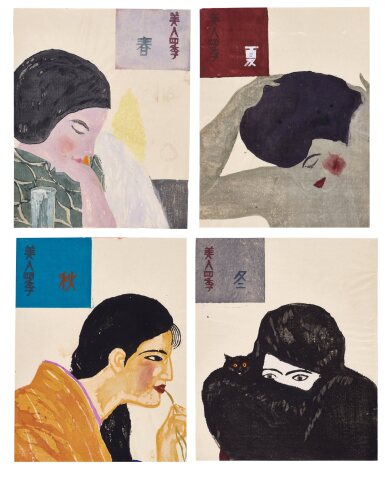Landscape to City: A Collection of 20th Century Japanese Prints
Landscape to City: A Collection of 20th Century Japanese Prints

Onchi Koshiro (1891-1955) | The complete set of Beauties of the Four Seasons (Bijin shiki) | Showa period, 20th century
拍品已結束競投
November 18, 03:55 PM GMT
估價
30,000 - 40,000 GBP
拍品資料
描述
Onchi Koshiro (1891-1955)
The complete set of Beauties of the Four Seasons (Bijin shiki)
Showa period, 20th century
the complete set of four woodblock prints from the series Beauties of the Four Seasons (Bijin shiki), accompanied by original paper folio with paper label titled, signed and dated Bijin shiki, K. Onzi, 1927 nen saku , 1930 nen shin suri (Beauties of the Four Seasons, K. Onzi, made in 1927, newly printed in 1930), and comprising:
- Spring (Haru)
- Summer (Natsu),
- Autumn (Aki)
- Winter (Fuyu)
Each 27.9 x 23.2 cm., 11 x 9⅛ in.
Onchi realized his series Beauties of the Four Seasons at a time when he highly espoused the contrasting palettes and pigments of the European Impressionists. The result was an almost uniquely western-style of the ukiyo-e beauty portrait (bijin-ga) that carried a sense urbanity and chicness synonymous with the fashions and styles of the Taisho (1912-1926) and early Showa periods (1926-1988). His women wear cropped coiffures or strikingly match their kimono with bold western-style make-up as in Autumn. In Winter, the model and her cat gaze piercingly at the viewer, both blanketed entirely in black furs.
The aristocrat-cum-book designer was inspired by the arts and designs of Takehisa Yumeji (1884-1934), a Bohemian socialist artist who flourished during the Taisho period. Onchi’s first prints were in the German expressionist style, and he is often recognised as a forerunner of abstraction in Japan. In collaboration with Fujiori Shizuo (1891-1943) and Tanaka Kyokichi (1882-1915), Onchi produced the journal Tsukuhae (1914-1915) and would later become the figurehead and main exponent of the Sosaku-hanga, or Creative Print movement.3
There are three known printings of the series Beauties of the Four Seasons. The first set was executed in 1927 with French titles accompanying each of the portraits: Le Printemps (Spring), L’Eté (Summer), L’Automne (Autumn) and L’Hiver (Winter). A second printing comprised of a total of eight sets was self-printed and issued the next year in February 1928. After a set was exhibited at the seventh Soten Exhibition (1927), a further printing was published by Nippon Hanga in 1930, replacing the French titles with their equivalent Japanese translations. Among all printings there are few extant in private and museum collections. Onchi believed instinctively in the print medium as a painting executed by block and many of his works were issued in small editions of only one or two.
A complete set of Beauties of the Four Seasons with French titles is in the collection of The National Museum of Modern Art, Kyoto, see Onchi Koshiro (Onchi Koshiro ten), exhib. cat., (Tokyo, 2016), p. 102-3, figs. P93-96. Two other complete impressions were formerly in the Helen and Felix Juda Collection and the F. Kawasaki Collection.
1. Quote by Onchi Koshiro in Lawrence Smith, ‘Japanese Prints 1868-2008’ in Since Meiji: Perspectives on the Japanese Visual Arts, 1868-2000, ed. J. Thomas Rimer, (Hawaii, 2012), p. 372.
2. Ibid, 371.
3. Onchi Koshiro (Onchi Koshiro ten), exhib. cat., (Tokyo, 2016), p. 102-3, figs. P93-96.
